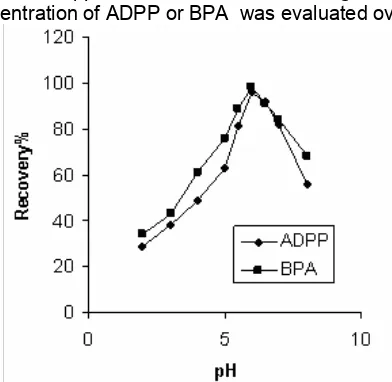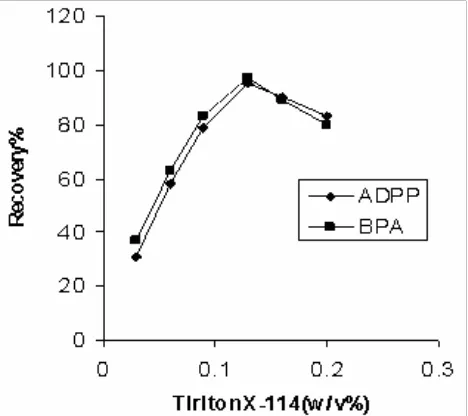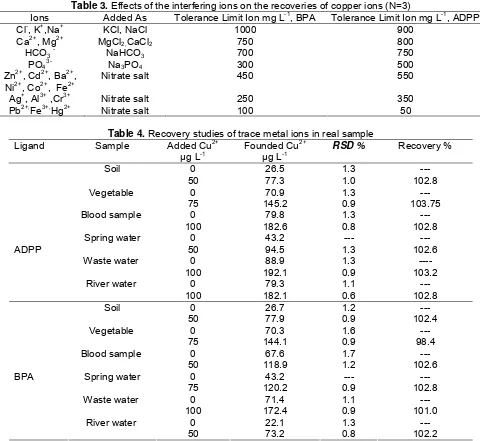F. Ahmadi, et al.
* Corresponding author. Tel: 3330965, Fax: (098)-742-3333533, Email: [email protected]
MICELLE-MEDIATED EXTRACTION AS A TOOL FOR SEPARATION AND
PRECONCENTRATION IN COPPER ANALYSIS
F. Ahmadia1,*, A. Khanmohammadi2 and A. Malekpour1 1
Chemistry Department, Gachsaran Azad University, Gachsaran, Iran
2Young Researchers Club, Gachsaran Azad University, Gachsaran, Iran
Received 18 August 2007; Accepted 9 September 2007
ABSTRACT
A cloud point extraction method was presented for preconcentration of copper in various samples. After complexation with 4-Amino-2,3-dimethyl-1-phenyl-3-pyrazoline-5-one (ADPP) or N-Benzoyl-N-phenylhydroxylamine (BPA) in water, analyte ions are quantitatively extracted to the phase rich in Triton X-114 after centrifugation. 2.0 mol L-1 HNO3 solution in methanol was added to the surfactant-rich phase prior to its analysis by flame atomic
absorption spectrometry (FAAS). The adopted concentrations for ADPP, Triton X-114, HNO3 and parameters such
as bath temperature, centrifuge rate and time were optimized. Detection limits (3SDb/m) of 1.3 and 1.9 ng mL-1 for ADPP and BPA along with enrichment factors of 30 and 38 for ADPP and BPA were achieved. The high efficiency of cloud point extraction to carry out the determination of analyte in complex matrices was demonstrated. The proposed method was applied to the analysis of biological, industrial, natural and wastewater, soil and blood samples.
Keywords: 4-Amino-2,3-dimethyl-1-phenyl-3-pyrazoline-5-one (ADPP), N-Benzoyl-N-phenylhydroxylamine (BPA) , Cloud Point Extraction, Triton X-114, Flame Atomic Absorption Spectrometry.
INTRODUCTION
Much interest and effort have been devoted on the studies for copper determination in water and biological matrices because it is a good tool for environmental and toxicological monitoring. The removal of copper from aqueous medium such as effluents also is of great interest for environmental and human health purposes.[1 ]Generally, The determination of trace copper in biological samples is particularly difficult because of the complex matrix and the usually low concentration of this element in such samples, which requires sensitive instrumental techniques and frequently a pre-concentration step [2-3].
The process involving cloud point extraction (CPE) may be adopted as an alternative to conventional solvent extraction due to a number of possible advantages including attainability of large preconcentration factors and reducing of the consumption of a solvent, disposal costs and extraction time [4-6]. Moreover, aqueous micellar solutions can replace the more dangerous and toxic organic solvents, allowing to perform the analysis under mild conditions [7, 8].
Separation procedures based on the peculiar properties of aqueous non-ionic and zwitterionic surfactant solution have also been proposed as an alternative to the use of traditional organic solvents. Aqueous solutions of almost all non-ionic surfactants become turbid when heated to a temperature known as the cloud point. Above this temperature, the isotropic micellar solution separates into two transparent liquid phases: a surfactant-rich phase of very small volume
composed mostly of the surfactant plus a small amount of water, and an aqueous phase, in equilibrium with the former, which contains a surfactant concentration close to its critical micellar concentration, is the base of cloud point extraction (CPE). The small volume of the surfactant-rich phase obtained with this methodology permits the design of extraction schemes that are simple, cheap, highly efficient, and of lower toxicity to the environment than those extractions that use organic solvents. The CPE phenomenon has been used for the extraction and preconcentration of metal cations [9-15] after the formation of sparingly water-soluble complexes. CPE has been shown to be an effective sample preconcentration technique for improving sensitivity and selectivity prior to atomic spectrometry measuring method.
In the present work a simple, selective and sensitive CPE method for preconcentration and determination of copper ion in various real samples using ADPP and BPA as selective and sensitized complexing agent was established.
EXPERIMENTAL SECTION
Reagents and Materials:
Indo. J. Chem., 2007, 7 (3), 278-283
F. Ahmadi, et al.
279
Instrumentation
A Shimadzu UV-Vis 160A spectrophotometer was used to measure the absorbance of complex in Triton X-114 media. A Metrohm 691 pH/Ion meter with a combined glass and calomel electrode has been used for pH measurement. A Shimadzu 680 A atomic absorption spectrometer was used for copper determination.
Procedure
A typical cloud point experiment required the following steps: an aliquot of 15 mL of a solution containing Cu2+, 0.13 % Triton X-114 and 3 mM of ADPP or 2.5 mM of BPA were adjusted to pH= 6.0 with a acetate buffer. The mixture was shaken for 1 min and left to stand in a thermo-stated bath at 50 oC, for 20 min. Separation of the phases was achieved by centrifugation at 4000 rpm, for 15 min. The whole system was cooled in an ice-bath so for 15 min that the surfactant rich phase would regain its viscosity. In this way, the bulk aqueous phase was easily decanted. The remaining micellar phase was dissolved in 0.5 mL of 2.0 M HNO3 in
methanol and then the copper content was readily evaluated by FAAS.
Pretreatment of Real Samples
Analysis of waste water sample for determination of copper ions content was performed as following: 400 mL of sample was transferred to a beaker and 8 mL concentrated HNO3 and 3 mL of 30% H2O2 were added
for elimination and decomposition of organic compound. The sample solution while stirring was heated to one tenth of initial volume. After adjustment of sample pH to desired value the CPE were performed according to general described procedure [2].
Blood and Soil
Homogenized soil (50 g) or blood sample (50 mL) was weighed accurately and transferred into a 200 mL beaker and digested in the presence of oxidizing (25 mL concentrated HNO3 and 5 mL HClO4 70 % ) with heating
for 1 h. The beaker content was filtered through a Whatman # 40 filter paper into a 250 mL volumetric flask and its pH was adjusted to desired value and diluted to mark with de-ionized water. Standard addition method was used for determination of copper in real samples.
Vegetables
All vegetable samples were purchased from Gachsaran Iran. Afterwards, they were taken in small mesh. A 50 g vegetable sample was heated in silica crucible for 3 h on a hot plate and the charred material was transferred to furnace for overnight heating at 650 °C. The residue was cooled, treated with 12 mL concentrated nitric acid and 4 mL 30% H2O2 again kept
in furnace for 2 h at the same temperature (650 °C) so
that no organic compound traces are left. The final residue was treated with 3 mL of concentrated hydrochloric acid and 3-5 mL of 70% perchloric acid and evaporated to fumes, so that all the metals change to respective ions. The solid residue was dissolved in water, filtered and by keeping the pH at 6.0 made up to 25 mL by addition of KOH and acetate buffer. The dissolved solution was suitably diluted and metal concentrations were determined after suitable preconcentration using AAS. [16]
RESULT AND DISCUSSION
Effect of pH
CPE of copper ion was performed in solutions of pH ranging from 2 to 8. Separation of metal ions by cloud point method involves the prior formation of a complex with sufficient hydrophobicity to be extracted in to the small volume of surfactant-rich phase. Extraction recovery depends on the pH at which complex formation occurs. Fig 1 shows the effect of pH on the extraction of copper complex. It was found that at pH= 6.0, extraction is quantitative. The decrease in signal at pH > 6.0 is probably due to the precipitation of copper ions in the form of hydroxide, and at pH<6.0 may be due to competition from hydronium ion toward protonation ADPP or BPA. In subsequent experiments pH = 6.0 was selected as optimum pH value.
Effect of ADPP or BPA concentration on copper
CPE recovery
The effect of ADPP or BPA as a complexing agent for copper ion extraction was investigated. The concentration of ADPP or BPA was evaluated over the
Fig 1. Effect of pH on copper ion extraction,
F. Ahmadi, et al.
Fig 2. Effect of ADPP or BPA concentration on copper ion extraction by CPE, Conditions: 15 mL of 0.2 μg mL-1 Cu2+ ion at pH 6.0, 0.13 (w/v) Triton X-114, different concentration of ADPP or BPA, 1.0 % (w/v) NaCl, eluting solution 0.5 mL of 2.0 M HNO3 in methanol.
range of 1.0-5.0 mM. For this study, 15 ml of a solution containing 0.2 ng mL−1 copper ion in 0.13% (w/v) Triton X-114 with various amounts of ADPP or BPA was subjected to the cloud point preconcentration process. The results show that in the concentration range of 2.5-4.5 mM of ADPP or BPA the extraction of copper ion is complete. The extraction recovery as a function of the ADPP concentration is shown in Fig 2(A) concentration of 3.0 mM of ADPP or 2.5 mM of BPA was chosen as optimum for subsequent experiments.
Effect of Triton X-114 concentration
The preconcentration efficiency was evaluated using variable Triton X-114 concentrations ranging from 0.03% to 0.2% (w/v). The results are demonstrated in Fig 3. As it is seen, the highest copper ion recovery was obtained with 0.13% (w/v) Triton X-114. By decreasing the surfactant concentration to 0.03% (w/v) the recovery is reduced. The copper ion recovery also decreased for a Triton X-114 concentration greater than 0.13% (w/v). This result might be related to the presence of the high amount of surfactant, resulting in an increase in the volume of the surfactant-rich phase. In addition, the viscosity of the surfactant-rich phase increases, leading to poor sensitivity [17, 18]. At lower Triton X-114 concentrations (below 0.03% w/v), the preconcentration efficiency of the complex was very low, probably due to inability for quantitatively entrapment of hydrophobic complex [19]. So, 0.13% (w/v) of surfactant concentration was selected as optimum concentration of Triton X-114.
Fig 3. Effect of Triton X-114 on copper ion extraction by CPE, Conditions: 15 ml of 0.2 μg mL-1 Cu2+ ion at pH 6.0, 3.0 mM ADPP or 2.5mM BPA, 1.0 % (w/v) NaCl, various amounts of Triton X-114, eluting solution 0.5 mL of 2.0 M HNO3 in methanol.
Effect of NaCl concentration
Some investigations such as the effect of anionic and non-ionic surfactants and also NaCl, KNO3 and
MgCl2 electrolytes on the cloud point behavior of
non-ionic surfactants have been reported [20-22]. It is observed that the presence of electrolytes decreases the cloud point (salting-out effect), resulting in a more efficient extraction. The lower cloud point is attributed to electrolytes promoting dehydration of the poly(oxyethylene) chains [23]. According to Hiller et al.
Indo. J. Chem., 2007, 7 (3), 278-283
F. Ahmadi, et al.
281
Effect of added methanol volume
Since the surfactant-rich phase obtained after the cloud point preconcentration contains a high concentration of Triton X-114 and, at the same time, the volume obtained is rather small (0.5 mL), methanol containing 2.0 mol L-1 HNO3 was added to the
surfactant-rich phase after phase separation. Moreover, it was necessary to decrease the viscosity of the rich phase without excessive dilution of the micelle to facilitate the introduction of the sample into the atomizer of the spectrometer. There is an optimum volume (0.5 mL) with respect to the copper ion recovery. Smaller volumes of methanol were not tested because in this case it was not possible to quantitatively transfer the rich phase from test tubes to the graduated tubes and measuring the absorbance. Larger volumes of acidified methanol solution results a gradual absorbance reduction. A 500 μl volume of ethanol was therefore used throughout the remaining experiments.
Effect of temperature and time
Optimal incubation time and equilibration temperature are necessary to complete the CPE process, and to achieve easy phase separation and pre-concentration as efficient as possible. Providing that the complexation reaction has been completed under certain conditions, relevant data show that, for equilibration times of some minutes up to a few days, extraction efficiency increases very slightly and the phase-volume ratio decreases a little [24]. On the other hand, it appears that the phase volume ratio of all non-ionic surfactants decrease as the equilibration temperature increase. The greatest analyte pre-concentration factors are thus expected under conditions where the CPE is conducted using equilibration temperatures that are well above the cloud point temperature of the surfactant. It is observed that the temperature of 45 oC is adequate for Cu analysis. Higher temperatures lead to the decomposition of ADPP-Cu or BPA-Cu complexes and the reduction of analytical signal. At lower temperatures the separation of the two phases is not complete. The incubation time is kept at 20 min which is sufficient for the completion of the physicochemical processes.
Effect of Centrifuge time and rates
It is required to preconcentrate trace amount of copper ion with high efficiency in a short time. Therefore, CPE on a set of experiments of 15 mL sample at 0.13% (w/v) Triton X-114, pH= 6.0, 3.0 mM ADPP or 2.5mM BPA, 0.2 μg mL-1 of copper ion and 1% NaCl by heating at 50 ْ oC and centrifuging in various rates and times and further cooling in various times has been carried out. The results indicate that the experiment in the optimized reagent concentration after heating for 20 min in 50 oC
and centrifuging by 15 min in 4000 rpm and cooling in 15 min in ice-bath lead to high recovery of copper ion in CPE process.
Characteristics of the method
Calibration graph is obtained by preconcentration of different standard copper ion concentrations standard solution under the experimental conditions. The solutions were introduced into the flame by conventional aspiration. Table 1 gives the characteristic performance of the proposed method of standard solutions subjected to the entire procedure. Limits of detection and quantification according to IUPAC are also included. The limit of detection and the linear range of the proposed method are comparable to other methods that also employed FAAS. The characteristics of the proposed method are shown in Table 2.
Effect of foreign ions
CPE procedures for copper ion determination in the high salt content samples can be strongly affected by the matrix constituents of the sample . The influences of some alkaline and alkaline-earth ions and transition metal ions on the recovery of the copper ion were investigated. The results are given in Table 3. The tolerance limit is defined as the ion concentration causing a relative error smaller than ± 5% related to the preconcentration and determination of Cu2+ ion. Copper ion was quantitatively recovered in the presence of large amounts of alkaline and alkaline-earth ions and some transition metal ions.
Table 1. Optimum parameters of proposed method Parameter BPA ADPP
pH 6.0 6.0
Table 2. Specification of method at optimum conditions for each ligand
Parameter ADPP BPA
Linear Range (µg mL-1) 0.01-0.9 0.02-0.7
Detection Limit (ng mL-1) 1.3 1.9
RSD % 2.1 1.7
F. Ahmadi, et al.
Table 3. Effects of the interfering ions on the recoveries of copper ions (N=3)
Ions Added As Tolerance Limit Ion mg L-1, BPA Tolerance Limit Ion mg L-1, ADPP
Table 4. Recovery studies of trace metal ions in real sample
Ligand Sample Added Cu2+
Blood sample 0
100
Blood sample 0
50
Accuracy and applications
We have explored the feasibility of the methodology using preconcentration with ADPP or BPA in surfactant media for the determination of copper ion in different matrices treated according to experimental section. The procedure was applied to the determination of copper ion in different samples, including waste water, river water, soil and blood samples, vegetable sample, liver sample and chocolate samples by standard addition method. Reliability was checked by spiking experiments and independent analysis. The results are presented in Table 4. The recoveries of spiked samples are satisfactory and were confirmed using standard addition method, which indicate the capability of the system in the determination of copper in natural water samples.
CONCLUSION
The combined advantages of the cloud point methodology (easy, safe, rapid and inexpensive) and the use of ADPP or BPA as a chromogenic reagent (selectivity and sensitivity) for Cu was utilized for their determination in water samples. The method gives a very low limit of detection and good R.S.D. values. The results of this study clearly show the potential and versatility of this method, which could be applied to monitoring Cu spectrophotometrically in real samples
REFFERENCES
Indo. J. Chem., 2007, 7 (3), 278-283
F. Ahmadi, et al.
283
2. Ghaedi, M., Ahmadi, F., Karimi, H., and Gharaghani, S., 2006, Korean J.Chem.1 23.
3. Ghaedi, M., Fathi, M.R., Marahel F., and Ahmadi, F., 2005, Environm. Bull., 14, 1158.
4. Safavi, A., Abdollahi, H., Nezhad, M.R.H., and Kamali, R., 2004, Spectrochim. Acta, Part A, 60, 2897.
5. Nascentes, C.C., Arruda, M.A.Z., and Maniasso, N., 2002, Quim. Nova, 25, 483.
6. Ohashi, A., Tsuguchi, A., Imura, H., and Ohashi, K., 2004, Anal. Sci., 20, 1091.
7. Pramauro, E., and Prevot, A.B., 1995, Pure Appl. Chem. 4, 551.
8. Manzoori, J.L., and Nezhad, G.K., 2004, Anal. Chim. Acta., 521, 173.
9. Manzoori, J.L. and Bavili-Tabrizi, A. 2002, Anal. Chim. Acta, 470, 215.
10. Kulichenko, S.A., Doroschuk, V.O., and Lelyushok, S.O., 2003, Talanta, 59, 767.
11. Manzoori, J.L. and Bavili-Tabrizi, A. 2002,
Microchem. J. 72, 1.
12. Silva, M.A.M., Frescura, V.L.A., Aguilera, F.J.N., and Curtius, A.J., 1998, J. Anal. At. Spectrom., 13, 1369.
13. Silva, M.A.M., Frescura, V.L.A., and Curtius, A., 2000, J. Spectrochim. Acta, 55 B, 803.
14. Chen, J., and Teo, K.C., 2001, Anal. Chim. Acta,
450, 215.
15. Tarley, C.R.T. ,and Arruda, M.A.Z., 2004, Anal. Sci. 20, 961.
16. Ghaedi, M., Spectrochim. Acta Part A Accepted. 17. Pinto, C.G., Pavo´n, J.L.P., and Cordero, B.M.,
1996, J. Anal. At. Spectrom. 11, 37.
18. Tani, H., Kamidate, T., and Watanabe, T., 1997, J. Chromatogr. A 780, 229.
19.
20. Borges, D.L.G., Veiga, M.A.M.S., Frescura, V.L.A., Welz, B., and Curtius, A.J., 2003, J. Anal. At. Spectrom., 18, 501.
21. Gu, T., and Galera-Go´mez, P.A., 1995, A Physicochem. Eng. Asp., 104, 307.
22. Nascentes, C.C., and Arruda, M.A.Z., 2003,
Talanta, 61, 759.
23. Komaromy-Hiller, G., Calkins, N., and Wandruszka, R., 1996, Langmuir 12, 916.
24. Armstrong, J.K., Chowdhry, B.Z., Snowden, M.J., Leharne, S.A., 1998, Langmuir 14, 2004.



